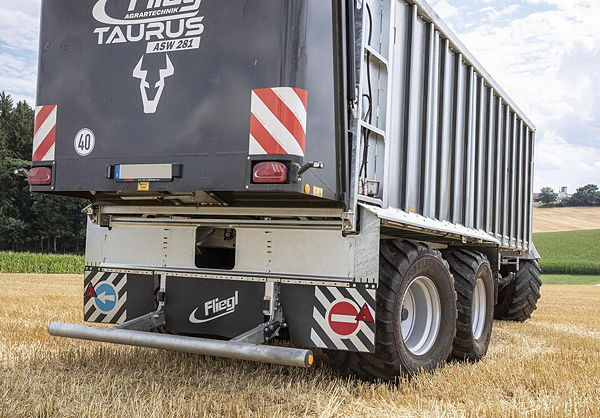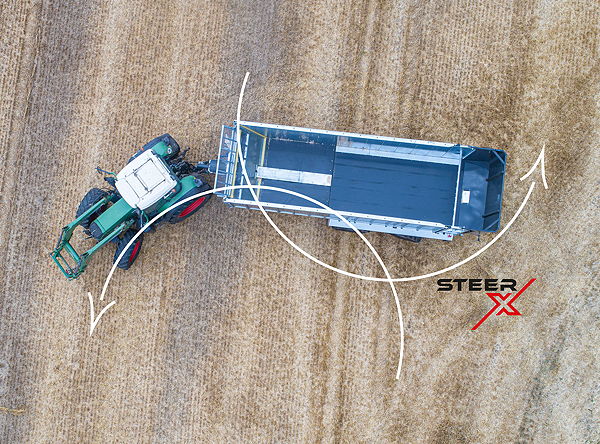2022-08-05 |
>
Fliegl SteerX – A New Dimension of Manoeuvrability
The new electronic forced steering SteerX broadens the horizon of axle steering because the system no longer requires a mechanical connection.
Agricultural transport vehicles have become increasingly larger over the years, while country roads, field access roads and farmsteads have often remained the same in size. Therefore, the challenge arises as to how agricultural vehicles with larger wheelbases and a larger distance between the coupling point and the pivot point can maintain their maneuverability. It is possible by reducing the drag curves resulting from the distance with the help of one or two steered axles. There are two options here: on the one hand, a self-steering system and on the other hand a forced steering system with actively controlled steering axles. Steered axles increase the driving comfort and at the same time reduce wear on axles and tires.
Conventional hydraulic self-steering systems have good maneuverability when driving forward and are easy to couple to any tractor. A single-acting connection to the steering axle lock is sufficient. However, the axis must be locked at higher speeds and on side slopes for safety reasons. The self-steering axle is also locked when reversing, which means that the turning radius worsens more or less, depending on the number of axles and the wheelbase.
In the case of mechanical-hydraulic forced steering, a coupling linkage with a K50 mount is attached next to the K80 coupling. The forced steering system must then be adapted to the towing vehicle. The advantage of this system: The steering axle is actively steered, intervenes when driving forwards and backwards and does not have to be locked manually via a control unit. The steering angle of the towing vehicle is restricted by the connecting rod or the master cylinder.
Common electro-hydraulic forced steering systems usually use a small coupling linkage around the K80 coupling, which converts the steering angle between the towing vehicle and the trailer into a signal. In most cases, this coupling is not standardized and the coupling rods are also very filigreely designed for "quick" coupling. The resulting damage to the linkage has a negative effect on the steering angle.
Fliegl relies on innovative sensor technology for its electronic forced steering, which does not require any coupling rods on the towing vehicle.
The sensor is on the trailer. Only load-sensing hydraulics and an Isobus connection on the tractor are required. If the tractor is not equipped with Isobus, Fliegl also offers an Isobus cable harness including a display.
If all data is available, the optimal steering angle is calculated based on the inclination and driving speed and the steering cylinder is moved to this position. Lateral forces when cornering are thus significantly minimized. As a result, the axle unit is protected and the tire wear decreases accordingly.
The intelligent system meets all functional safety requirements by constantly monitoring the steering-specific parameters. Even at higher speeds and unpredictable manoeuvres, the steering behavior adapts optimally and ensures a high level of driving stability. There is also an extensive operating software with diagnostic and service functions available.
STEER X at a glance:
• No additional coupling linkage required which means quick
coupling and a high steering angle to the drawbar
• Innovative sensor technology, thus less wear and maintenance costs regarding the chassis
• Improved driving stability
• High system security
• Available for many Fliegl tandem and tridem trailers
With the SteerX electronic forced steering, Fliegl gives maneuverability a new meaning.




